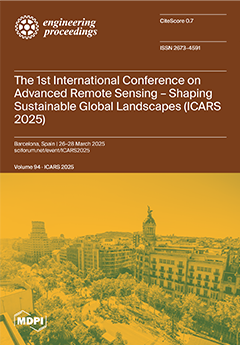Dinder Biosphere Reserve (DBR), a UNESCO-recognized biodiversity hotspot in Sudan, faces escalating land-use pressure. We analyzed land cover changes from 2019 to 2024 using Sentinel-2 imagery processed in Google Earth Engine. A Random Forest classifier identified five land cover classes: water, built-up areas,
[...] Read more.
Dinder Biosphere Reserve (DBR), a UNESCO-recognized biodiversity hotspot in Sudan, faces escalating land-use pressure. We analyzed land cover changes from 2019 to 2024 using Sentinel-2 imagery processed in Google Earth Engine. A Random Forest classifier identified five land cover classes: water, built-up areas, vegetation, bare land, and crops. The transition matrix revealed significant changes over this period. About 1501 km
2 of vegetation and 1648 km
2 of cropland were converted to bare land. Built-up areas lost 95 km
2 to bare land. Bare land remained largely unchanged (4749 km
2), while water bodies were the most stable (13,473 km
2 unchanged). Only minor transitions involved water (27.6 km
2 to vegetation, 15.2 km
2 to bare land). Notably, 411 km
2 of cropland and 1773 km
2 of bare land transitioned to vegetation, indicating some regrowth. These land cover changes reflect a dynamic interplay between degradation and recovery processes; however, the results should be interpreted with caution due to potential classification inaccuracies, seasonal variation in imagery, and absence of field validation. Continued satellite monitoring is essential to guide adaptive land management and safeguard ecosystem function in DBR.
Full article




